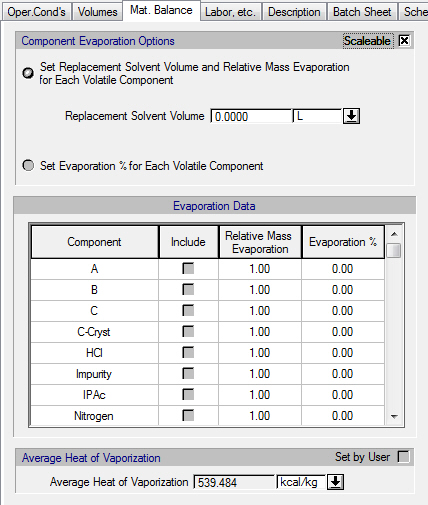

The following table shows a brief description of the variables appearing in this tab. The table also displays their default values and their generally acceptable range:
|
Variable |
Default Value |
Range |
|
|
||
|
○ Scalable |
Yes |
Yes/No |
|
◙ Replacement Solvent Volume (L) |
0.0 |
Positive |
|
○ Include |
No |
Yes/No |
|
◙ Relative Mass Evaporation |
1.0 |
Zero or Positive |
|
◙ Evaporation Percentage (%) |
0.0 |
[0,100] |
|
○ Set by User |
No |
Yes/No |
|
◙ Average Heat of Vaporization (kcal/kg) |
539.484 |
Positive |
Symbol Key: ○ User-specified value (always input); ● Calculated value (always output); ◙ Sometimes input, sometimes output
The following list describes the available specification choices in this tab; for more details on how these are implemented, see Batch Vaporization / Solvent Switch: Modeling Calculations.
•Component Evaporation Option...
If you select the top option (“Set Replacement Solvent Volume and Relative Mass Evaporation for Each Volatile Component”), you must specify the replacement solvent volume and you must also identify the volatile components and specify their relative mass evaporation in the Evaporation Data table. For instance if 3 kg of Acetone evaporate for every kg of Water, you should enter 3.0 for Acetone Relative Mass Evaporation and 1.0 for Water. This is necessary because this operation does not perform VLE calculations.
If you select the bottom option (“Set Evaporation % for Each Volatile Component”), you must identify the volatile components and specify their evaporation % in the Evaporation Data table.